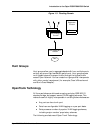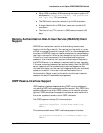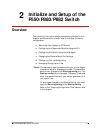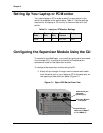
Cajun P550R/P880/P882 Switch User Guide
Introduction to the Cajun P550R/P880/P882 Switch
1-23
Dual-Layer Spanning Tree Protocol Option
Dual-Layer spanning tree mode is a variation of per-VLAN spanning
tree mode with many of the same features. However, instead of
using normal BPDUs, which are clear (free of VLAN tags) on clear
links and tagged on tagged links, as is the case with Per-VLAN
Spanning Tree mode, dual-layer uses a proprietary BPDU. This
proprietary BPDU is sent to a special multicast address and contains
information about which VLAN the BPDU is associated with. This
has an advantage over per-VLAN spanning trees in that this method
can support multiple VLANs over a non-tagging link, or when
connecting to a bridge/router.
In this mode, Legacy Bridges remain in separate Spanning Tree
domains, yet loops between the layer 3 and Legacy domains cannot
form. For example; if there are three P550 switches in a network
running VLAN A and VLAN B, and three legacy devices connect up
through a port configured in VLAN A, the legacy devices remain in
their own Legacy Spanning Tree and NOT join the Multilayer
Spanning Tree.
In the previous example, all three switches participate in two
Spanning Tree domains:
■ Domain for VLAN A containing three bridges
■ Domain for VLAN B containing three bridges with the legacy
domain remaining separate.
The legacy devices need not be aware of the other spanning tree
domains. If a loop forms between the Multilayer domains and the
legacy domain, the Proprietary BPDU is seen returning to the
Multilayer domain through the Legacy domain and the loop is
blocked. The Dual-Layer Spanning Tree method is preferred when
inter-operating with large legacy bridge networks. Convergence
time is reduced, and management is simplified, by allowing the
legacy bridges to remain in their own spanning tree domain


















